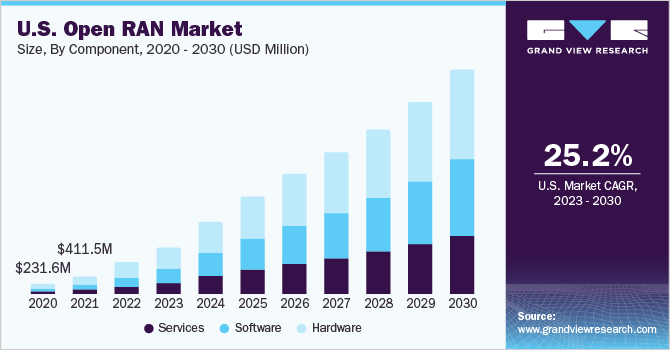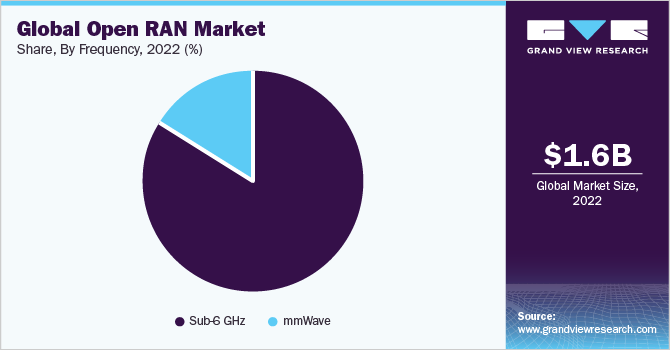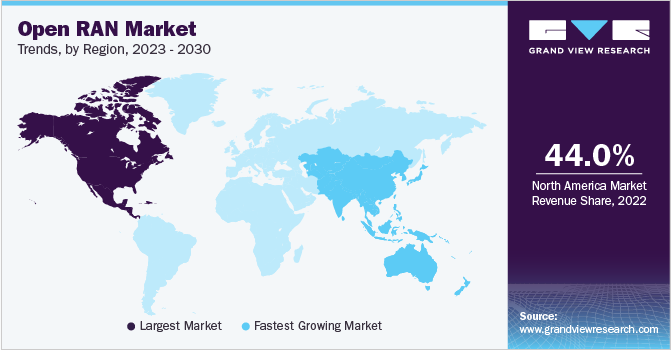
Open RAN Market Size, Share & Trends Analysis Report By Deployment (Private, Public Cloud), By Network (4G, 5G), By Component (Software, Services), By Frequency (Sub-6 GHz, mmWave), By Unit, And Segment Forecasts, 2023 - 2030
- Report ID: GVR-4-68040-117-3
- Number of Pages: 113
- Format: Electronic (PDF)
- Historical Range: 2019 - 2021
- Industry:Technology
Report Overview
The globalopen RAN market sizewas estimated atUSD 1,647.5 million in 2022and is expected to grow at a compound annual growth rate (CAGR) of 33.0% from 2023 to 2030. An open radio access network, or O-RAN, is a nonproprietary version of the radio access network (RAN) that allows interoperation between cellular network equipment provided by different vendors. Open RAN enables operators to choose hardware and software solutions from various vendors, which can lead to reduced equipment and operational costs. The vendor diversity, cost reduction, and flexibility offered by open RAN are anticipated to drive the market's growth over the forecast period. In February 2018, China Mobile, AT&T Inc., Deutsche Telekom, Orange, and NTT DOCOMO, founded the O-RAN ALLIANCE.

The ALLIANCE aims to reshape the RAN industry toward more open, intelligent, and virtualized fully interoperable mobile networks. O-RAN-based mobile network improves network operators' operational efficiency. In addition, the forum set O-RAN specifications that enable a more vibrant and competitive RAN supplier ecosystem with quicker innovations to improve user experience. The O-RAN ALLIANCE plays a central role in developing the Open Radio Access (O-RAN) network market. Open RAN enables operators to choose different hardware and software components from various vendors per their budgetary constraints. This freedom of choice regarding components and vendors translates into a cost-effective and flexible ecosystem compared to the traditional RAN architecture.
In addition, the implementation and maintenance costs associated with network deployment also decrease due to this flexibility. This inherently drives the competition in the market, pushing vendors to drive down prices even further. Thus, the cost-effective and flexible nature of O-RAN is expected to drive its adoption over the forecast period. In addition to reducing the overall cost, network operators can opt for components from various vendors and fine-tune their networks to deliver optimal performance. It allows operators to tailor their offerings to accommodate accelerated data speeds, increased service reliability, and thus improved customer experience.
Furthermore, the collaboration between various equipment providers and network operators allowed by O-RAN makes it easier for operators to deploy new features and services. The open standards allow for more flexibility and customization, thus fostering innovation in the market. The open RAN is still in its nascent stages of development and still requires some standardization efforts. Network standardization is important to ensure that different components from different vendors can work together seamlessly. Security concerns arise in the market as new technology introduces new security risks. Open RAN networks need to be more secure to protect customer’s data. However, as the market matures over time, these hurdles will be overcome with the evolving technology and ecosystem of the O-RAN.
COVID-19 Impact Analysis
The COVID-19 pandemic had an adverse impact on the market growth. The development and deployment of O-RAN gained momentum in early 2020 as the O-RAN alliance was formed in 2018. However, the innovation and development in the market were delayed due to the adversities of the pandemic. The COVID-19 pandemic caused significant delays in deploying 5G networks across the globe. However, in 2021, the market witnessed O-RAN technology trials and was set to deploy open-RAN technology in new-age networks, satisfying various use cases, especially in dense urban areas. Even though the pandemic delayed innovation and deployment, the market gained significant momentum post-pandemic and the investment influx in the market increased.
Component Insights
The hardware segment dominated the market in 2022 and accounted for a revenue share of more than 48.0%. Open RAN hardware specifically refers to the physical equipment and infrastructure of the radio access network in an open RAN architecture. Some of the common hardware components include baseband units (BBUs), remote radio units (RRUs), and virtualized RAN (vRAN) servers, among others. The O-RAN hardware allows operators to replace legacy 4G/3G/2G systems with fully virtualized Open RAN technology. Moreover, the hardware enables multiple technologies to run simultaneously on the same RRH to provide flexible and superior voice and data services to the end-users, driving the segment’s adoption and growth.
段预计如果注册的服务gnificant growth over the forecast period. The services segment is further bifurcated into consulting, deployment & implementation, and support & maintenance. Since O-RAN is a comparatively new technology, network operators need adequate support to ensure the efficiency and operability of the network. In addition, operators and vendors need to be trained on how to use the O-RAN for their maximum advantage. The growing demand for consulting, deployment & implementation, and support & maintenance services is anticipated to propel the segment’s growth over the forecast period.
Unit Insights
The radio unit segment dominated the market in 2022 and accounted for a revenue share of more than 38.0%. The radio unit is an important component of the open RAN architecture. It transmits, receives, amplifies, and digitizes the radio frequency signals. The radio unit is near or integrated into the antenna. The radio unit holds significance in the O-RAN market as it enables wireless communication between the user device and the core network. The growing use of radio units to enhance network performance is driving the segment’s growth.
The distributed unit segment is anticipated to grow significantly over the forecast period. The distribution unit converts a signal from one form to another and aggregates all data to be transmitted over a communication channel. The distribution unit takes the digitized radio signal from the radio unit and sends it into the network. The DU is used at the base station for computation, and it plays an important role in transmitting the radio signal, which is anticipated to drive the segment’s growth over the forecast period.
Deployment Insights
The hybrid cloud segment dominated the market in 2022 and accounted for a revenue share of more than 49.0%. Open RAN's hybrid cloud deployment combines on-premises and cloud infrastructure, optimizing network performance while leveraging scalability and cost efficiency. According to the survey results published by Mavenir regarding adopting O-RAN among enterprises, 78% of the surveyed organizations preferred hybrid or other cloud models for deploying O-RAN. Hybrid cloud deployment offers the public cloud's flexibility while providing the private cloud's security. Thus, the amalgamation of the two provided by hybrid cloud deployment is contributing to the segment's growth.
The private cloud segment is anticipated to grow significantly over the forecast period. Open RAN's private cloud deployment involves utilizing dedicated cloud infrastructure for enhanced network control and security. The private cloud deployment segment's growth can be attributed to the growing need for tailored solutions, data privacy compliance, and optimal resource utilization. Private cloud deployment offers efficient network management while addressing specific operational requirements of the organization, which is anticipated to drive the adoption of the private cloud segment over the forecast period.
Network Insights
The 4G segment dominated the market in 2022 and accounted for a revenue share of more than 43.0%. The market has witnessed 4G network deployments primarily due to their established infrastructure and widespread adoption across the globe. The dominant share of the 4G network can be attributed to the compatibility of open RAN solutions with the existing 4G setups. Moreover, the mature technology of 4G has led to significant deployments of Open RAN on the 4G network. Key players are focusing on enhancing and modernizing these networks while maintaining operational efficiency, thus boosting the segment’s growth.
The 5G segment is anticipated to register the highest growth rate over the forecast period. The majority of network operators and telecom equipment providers are focusing on creating a robust 5G ecosystem. The majority of the countries have already released 5G networks. The shift from 4G to 5G networks is driving open RAN network operators and providers to opt for 5G networks, which is driving the segment’s growth.
Frequency Insights
The sub-6 GHz segment dominated the market in 2022 and accounted for a revenue share of more than 83.0%. The sub-6 GHz frequency enables expansive coverage and better penetration through dense urban areas and rural areas where network connectivity is otherwise slow/poor. Hence, the sub-6 GHz frequency is better suited for urban as well as rural applications. It provides efficient data transmission improved user experience, and fulfills open RAN’s aim to enhance connectivity and accessibility. These benefits are anticipated to drive the market’s growth over the forecast period.

The mmWave segment is anticipated to grow significantly over the forecast period. The growth of the mmWave segment can be attributed to its ability to bring ultra-fast speeds and high data capacity. Even though mmWave offers network connectivity over a shorter range, the ultra-fast speeds provided by the frequency are driving its adoption in the O-RAN market. Moreover, as 5G expands, mmWave's role within O-RAN becomes more crucial for delivering the high-speed, high-capacity performance users expect in various environments, thus propelling the segment’s growth.
Regional Insights
North America dominated the market in 2022 and accounted for a share of more than 44.0% of the overall revenue. The segment's growth can be attributed to several factors, including the presence of prominent key players, such as AT&T, Inc., and the region's technological inclination toward early adoption of advanced solutions. Moreover, the region is witnessing significant investment in telecommunication infrastructure, creating significant growth opportunities for adopting O-RAN. The convergence of these factors has propelled North America to the forefront of Open RAN expansion, fostering the regional market’s growth and development in the market.

Asia Pacific is anticipated to register significant growth over the forecast period. The region's growth can be attributed to the increasing demand for advanced telecommunication infrastructure, a growing mobile subscriber base, and favorable government regulations. Countries, such as Japan, South Korea, and India, are at the forefront of regional growth due to their technological prowess and growing emphasis on fostering a robust digital ecosystem. All these factors are contributing to the growth of the regional market.
Key Companies & Market Share Insights
The market is still in its nascent stages and moderately consolidated with a few players driving the innovation and deployment. The O-RAN technology is fairly new, and the deployment of O-RAN has been recently commercialized. Key players are engaging in strategic partnerships to offer O-RAN hardware, software, and services. For instance, in February 2023, Deutsche Telekom announced its plans to partner with Fujitsu, Nokia Corp., and Mavenir, among others, for the initial commercial introduction of O-RAN in Germany from 2023 onwards. Such initiatives are harnessing the growth of the market. Moreover, the growing demand for flexibility and cost-effectivity offered by O-RAN is contributing to the market’s growth.Some of the prominent players in the global open RAN market include:
Mavenir
NEC Corp.
Fujitsu Limited
Nokia Corporation
Samsung Electronics Co., Ltd.
Radisys Corporation
Parallel Wireless
ZTE Corporation
AT&T Inc.
Huawei Technologies Co., Ltd.
Open RAN Market Report Scope
Report Attribute |
Details |
Market size value in 2023 |
USD 2,771.2 million |
Revenue forecast in 2030 |
USD 20.41 billion |
Growth rate |
CAGR of 33.0% from 2023 to 2030 |
Base year of estimation |
2019 - 2021 |
Historical data |
2022 |
Forecast period |
2023 - 2030 |
Quantitative units |
Revenue in USD million and CAGR from 2023 to 2030 |
Report coverage |
Revenue forecast, company market share, competitive landscape, growth factors, and trends |
Segments covered |
Component, unit, deployment, network,frequency, region |
Regional scope |
北美;欧洲;亚太地区;拉丁美洲; MEA |
Country scope |
U.S.; Canada; UK; Germany; France; Italy; India; Japan; Australia; South Korea; Malaysia; Brazil; Mexico; KSA; UAE; South Africa |
Key companies profiled |
Mavenir; NEC Corp.; Fujitsu Ltd.; Nokia Corp.; Samsung Electronics Co., Ltd.; Radisys Corp.; Parallel Wireless; ZTE Corp.; AT&T Inc.; Huawei Technologies Co., Ltd. |
Customization scope |
Free report customization (equivalent to up to 8 analysts working days) with purchase. Addition or alteration to country, regional & segment scope |
Pricing and purchase options |
Avail customized purchase options to meet your exact research needs.Explore purchase options |
Global Open RAN Market Report Segmentation
The report forecasts revenue growth at global, regional, and country levels and provides an analysis of the latest trends in each of the sub-segments from 2019 to 2030. For this study, Grand View Research has segmented the open RAN market report based on component, unit, deployment, network, frequency, and region:
Component Outlook (Revenue, USD Million, 2019 - 2030)
Hardware
Software
Services
Consulting
Deployment and Implementation
Support and Maintenance
Unit Outlook (Revenue, USD Million, 2019 - 2030)
Radio Unit
Distributed Unit
Centralized Unit
Deployment Outlook (Revenue, USD Million, 2019 - 2030)
Private
Hybrid Cloud
Public Cloud
Network Outlook (Revenue, USD Million, 2019 - 2030)
2G/3G
4G
5G
Frequency Outlook (Revenue, USD Million, 2019 - 2030)
Sub-6 GHz
mmWave
Regional Outlook (Revenue, USD Million, 2019 - 2030)
North America
U.S.
Canada
Europe
UK
Germany
法郎e
Italy
Asia Pacific
India
Japan
Australia
South Korea
Malaysia
拉丁美洲
Brazil
Mexico
Middle East & Africa
Kingdom of Saudi Arabia (KSA)
UAE
South Africa
常见问题关于这个报告
b.The global open RAN market size was estimated at USD 1,647.5 million in 2022 and is expected to reach USD 2,771.2 million in 2023.
b.The global open RAN market is expected to grow at a compound annual growth rate of 33.0% from 2023 to 2030 to reach USD 20.41 billion by 2030.
b.North America dominated the market in 2022. The segment's growth can be attributed to several factors, including the presence of prominent key market players such as AT&T, Inc. and the region's technological inclination towards early adoption of advanced solutions.
b.Some key players operating in the open RAN market include Mavenir, NEC Corporation, Fujitsu Limited, Nokia Corporation, Samsung Electronics Co., Ltd., Radisys Corporation, Parallel Wireless, ZTE Corporation, AT&T Inc., Huawei Technologies Co., Ltd.
b.Open RAN enables operators to choose hardware and software solutions from various vendors, which can lead to reduced equipment and operational costs. The vendor diversity, cost reduction, and flexibility offered by open RAN are anticipated to drive the market's growth over the forecast period.
We are committed towards customer satisfaction, and quality service.
"The quality of research they have done for us has been excellent."






